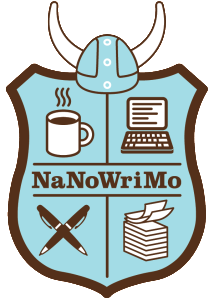by James Scott Bell
@jamesscottbell
 Yes, it’s almost here, November—which is National Novel Writing Month (NaNoWriMo). This singular event challenges writers all over the world to complete a 50,000 word (or more) novel in only one month.
Yes, it’s almost here, November—which is National Novel Writing Month (NaNoWriMo). This singular event challenges writers all over the world to complete a 50,000 word (or more) novel in only one month.
I’ve participated a few times in the past and produced a couple of published books out of it. (Not, I quickly note, without a lot of revision work!) While that is all well and good, there is perhaps a better reason for jumping in—to recapture the joy of writing.
I love the NaNo vibe. Writers writing. Newbies trying. Keyboards clacking. Coffee brewing. Possibilities awakening. It’s a major accomplishment to finish a novel. To do it in one month is astounding.
Of course, it’ll only be a first and very rough draft. But it will exist. You can let it sit for a month and then figure out what to do with it. One likely outcome is that you’ll use it as a “discovery draft” that now allows you to structure a re-write. Another is that the novel never sees the light of day. That’s fine, so long as you get some writing lessons out of it. Analyze the draft. Judge your craft. Make a plan to strengthen your skills.
At the very least you will have proved something to yourself. Unless you’re a full-time writer, averaging 1667 words a day is hard. Doing so for a month stretches you. When you get back to your normal rate of production, try to up it by 10% now that you’ve gone through NaNo.
Here are three other NaNo tips:
Plan
NaNoWriMo is catnip for pantsers. But a little planning (starting today) can make all the difference in your final product.
First, take a day to do some free-form journaling on your idea. Who it’s about, why it matters, why anybody should care. Jot down scene ideas that come to mind, in random order.
Second, take one day to define your concept with a three sentence “elevator pitch.” This will be your plumb line, what keeps you from getting too far away from the essence of your story. Even if you go down rabbit trails, you can use this to get yourself back on the main track. (On the form of an elevator pitch, see my TKZ post here.)
Finally, brainstorm a tentative “mirror moment” for your main character. This beacon of light will help you find your way if you get stuck in the dark.
Write
Check out my 10 tips for powering through NaNoWriMo.
Try to get a “nifty 350” words done the very first thing in the morning (or second, after you get the coffee going … hey, maybe invest in a coffee maker with a timer!)
Don’t edit your work except for a quick review of your daily pages. If you can do that review right before hitting the sack, so much the better. Your “boys in the basement” will work through the night and you can dive into writing the next morning.
Take Part
Go to NaNoWriMo.org and sign up. It’s free, and will give you access to “pep talks” and local groups of participants.
Even if you’re not going for a NaNoWriMo “win,” you can still use November to re-charge your writing batteries. Cheer others on via social media and get excited about their progress. Use that positive energy in your own writing. Set a November goal. Try upping your quota for the month. Or complete the development of a new project.
But whatever you do, do it with a sort of wild abandon. Be a “crazy dumbsaint of the mind,” as Kerouac put it. Repossess your writing mojo. Then spread that out for a year, when you’ll come up to November again!
Anyone planning on doing NaNoWriMo this year? How about your past experience with it? Any tips for those who are about to try?

